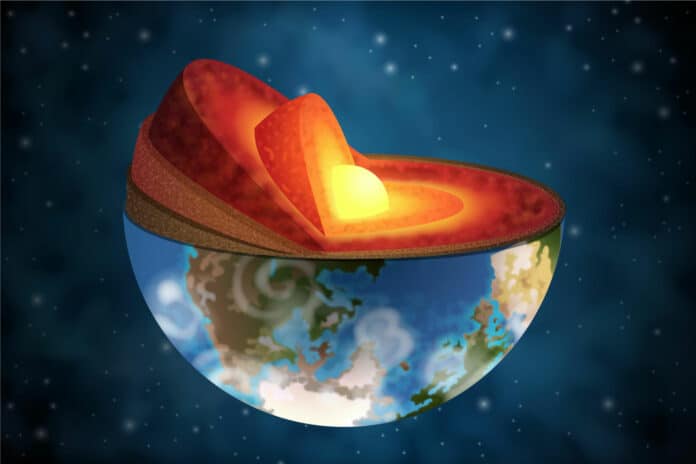The Earth’s crust is the Earth’s hard outer layer. It is less than 1% of Earth’s volume. It is made up of different types of rocks. The deeper you go, the stones start to sing at higher and higher pitches, if you can hear them.
Rocks include cracks, holes, and faults that, like strings, ring out when pushed or under stress. As a group of MIT geologists has discovered, you may learn something about the strength and depth of the rocks all around you by listening to the pattern and tempo of these noises.
MIT geologists listen to rocks to see whether acoustic patterns or “fingerprints” emerge in different pressures. According to recent laboratory experiments, marble samples under low pressure produce low-pitched “booms,” but at high pressure, the pebbles make an “avalanche” of higher-pitched crackles.
MIT geologist Matěj Peč said, “These acoustic patterns in rocks can help scientists estimate the types of cracks, fissures, and other defects that the Earth’s crust experiences with depth, which they can then use to identify unstable regions below the surface, where there is potential for earthquakes or eruptions.”
“If we want to tap these very hot geothermal sources, we must learn how to drill into rocks in this mixed-mode condition, where they are not purely brittle but also flow a bit. But overall, this is a fundamental science that can help us understand where the lithosphere is strongest.”
It is known that rocks near the surface are brittle and fracture more easily than rocks at greater depths. This suggests there must be an in-between — a phase in which rocks transition from one to the other and may have both properties, able to fracture like granite and flow like honey. Geologists think that this “brittle-to-ductile transition” may represent the region of the crust where rocks are at their strongest.
Peč says, “This transition state of partly flowing, fracturing, is critical because that’s where we think the peak of the lithosphere’s strength is and where the largest earthquakes nucleate. But we don’t have a good handle on this type of mixed-mode behavior.”
Scientists are studying how the strength and stability of rocks vary with rock’s microscopic defects. However, measuring the tiny defects in rocks is a challenging task. There is no visual-imaging technique to see inside rocks to map their microscopic imperfections.
Hence, the team turned to ultrasound. The idea is that any sound wave traveling through a rock should bounce, vibrate, and reflect off any microscopic cracks and crevices in specific ways that should reveal something about the pattern of those defects.
When they move under stress, each of these flaws will produce its unique sound; thus, actively sounding through the rock and listening to it should provide them with a wealth of information. They discovered that the concept ought to function with megahertz-frequency ultrasonic waves.
Peč explains, “This kind of ultrasound method is analogous to what seismologists do in nature, but at much higher frequencies. This helps us to understand the physics that occurs at microscopic scales during the deformation of these rocks.”
“It’s the same material as what Michaelangelo’s David is made from. It’s a very well-characterized material, and we know exactly what it should do.”
Each marble cylinder was put into a vice-like device created by steel, aluminum, and zirconium pistons, which can produce high tensions when combined. They inserted the vice into a pressurized chamber and then applied pressures to each cylinder that were comparable to those encountered by rocks across the Earth’s crust.
The scientists used ultrasound pulses to crush each rock progressively, and as they did so, they captured the auditory pattern that emerged from the bottom of the sample. The sensors were listening to any acoustic emissions that occurred spontaneously when they weren’t pulsating.
They discovered that the marble shatters suddenly in reaction to the lower end of the pressure range, where rocks are fragile, and the sound waves resembled huge, low-frequency booms. The acoustic waves at the highest pressures, where rocks are more ductile, sounded like a higher-pitched crackling. The research team thinks that minuscule flaws called dislocations, which spread and flowed like an avalanche, caused this crackling.
Peč says, “For the first time, we have recorded the ‘noises’ that rocks make when they are deformed across this brittle-to-ductile transition, and we link these noises to the individual microscopic defects that cause them.”
“We found that these defects massively change their size and propagation velocity as they cross this transition. It’s more complicated than people had thought.”
Scientists can predict how the Earth’s crust would behave at different depths by using the team’s characterizations of rocks and their defects at different pressures, such as how rocks might fracture in an earthquake or flow during an eruption.
Pec said, “When rocks are partly fracturing and partly flowing, how does that feed back into the earthquake cycle? And how does that affect the movement of magma through a network of rocks? Those are larger scale questions that can be tackled with research like this.”
Journal Reference:
- Hoagy O’Ghaffari, Matěj Peč, Tushar Mittal and Brian Evans. Microscopic defect dynamics during a brittle-to-ductile transition. PNAS. DOI: 10.1073/pnas.2305667120
